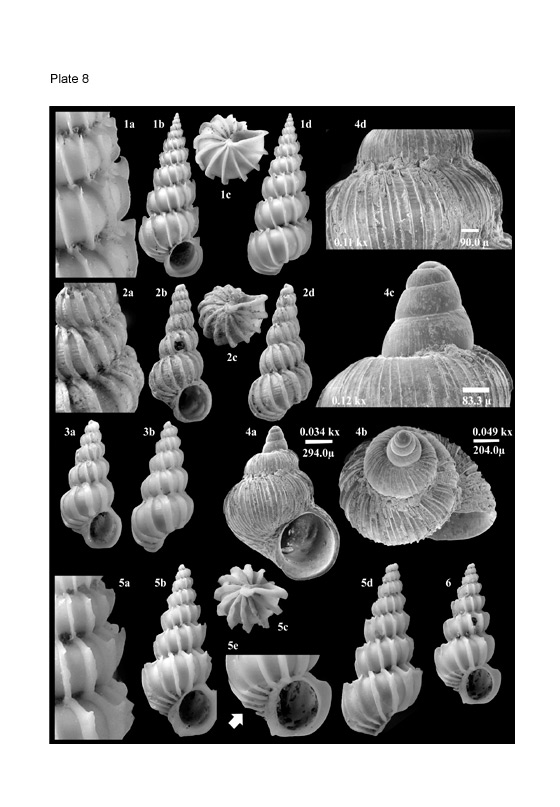
|

|
PALAEONTOS 10Price: non-members: 40 euros + postage, members: 35 euros + postage (96 textpages, 1 textfigure, 1 table, 22 plates) Landau B., La Perna R. & Marquet R., 2006, The Early Pliocene Gastropoda (Mollusca) of Estepona, Southern Spain. Part 6 – Triphoridae, Epitonioidea, Eulimoidea.Summary:In this part of the series, giving a systematic account of the Gastropoda of the Early Pliocene (Zanclean) deposits of Estepona, province of Málaga, Spain, the Triphoroidea, Epitonioidea and Eulimoidea are described and discussed. The faunal composition is compared with that present in the Atlantic, North Sea Basin and Mediterranean Pliocene to Recent. The usage of protoconch morphology alone to separate genera within the Cerithiopsidae H. & A. Adams, 1854 is not supported, and until further data is published, we consider that the genera Cerithiopsidella Bartsch, 1907, Vatopsis Gründel, 1980 and Dizoniopsis Sacco, 1895 cannot be separated from Cerithiopsis (sensu lato) Forbes & Hanley, 1851 on their protoconch morphology. The difficulty in describing taxa within the Triphoroidea on teleoconch morphology alone is discussed, as are the problems arising from a generic classification of cerithiopsids on protoconch morphology mentioned already for Cerithiopsidae. The fauna of Epitonioidea in Estepona is comparable in number of species and composition to that found in the Italian Pliocene, with most species showing a wide geological and geographical distribution, as would be expected of a group with predominantly planktotrophic development. The Eulimoidea are even less well-known in the fossil faunas. All but five are attributed to Recent taxa. At this stage in our knowledge on these families, few palaeogeographical or ecological conclusions can be drawn. Eleven species are new to science, Obesula protopaucispirata nov. sp., Seila plioiberica nov. sp., Epitonium iberomicroscopicum nov. sp., Epitonium debourymuricatum nov. sp., Dentiscala sinuosocostata nov. sp., Eulima velerinensis nov. sp., Eulima boucheti nov. sp., Melanella parviapertura, nov. sp., Melanella plioiberica nov. sp., Melanella wareni nov. sp. and Melanella pepediazi nov. sp. At the species-level, the following new synonymies are suggested: Cerithiella genei auct. North Sea Basin faunas (non Bellardi & Michelotti, 1840) = Cerithiella jansseni nov. sp.; Cerithiopsis manzonianus Cocconi, 1873, Cerithiella paucicincta and C. dertobicarinata Sacco, 1895 = Cerithiella genei (Bellardi & Michelotti, 1840); Scalaria lamellosa (Lamarck, 1822) = E. commutatum (Monterosato, 1877); Scalaria muricata Risso, 1826 nomen dubium, Pliocene fossil shells known under this name become Epitonium debourymuricatum nov. sp.; Clathrus spretus and C. gregorioi De Boury, 1890 = Epitonium proximus (De Boury, 1890); Scalaria jolyi Monterosato, 1878 = Epitonium sepetemcostatum (Conti, 1871); Scalaria sublamellosa Seguenza, 1876 and Scalaria aspromontana Seguenza, 1880 = Cirsotrema (Cirsotrema) lamellosum (Brocchi, 1814); Scalaria cochlea Sowerby, G. B. II, 1844 = Cirsotrema (Cirsotrema) pumiceum (Brocchi, 1814); Pliciscala (Nodiscala) bimonilifera Boettger, 1901, Nodiscala angulipunctata and Nodiscala rugatina De Boury in Cossmann, 1912 = Nodiscala scacchii (Hörnes, 1856); Punctiscala forestii De Boury, 1890 and Punctiscala longiuscula Sacco, 1891 = Punctiscala plicosa (Philippi, 1844); Eulima (Subularia) distincta Cerulli-Irelli, 1914 = Eulima bilineata Alder, 1848. The name Helix subula d’Orbigny, 1852 is chosen to replace Helix subulata Brocchi, 1814, primary homonym, but not synonym, of Turbo subulatus Donovan, 1803. These families are poorly known in the European fossil faunas, this being the most complete account in the Mediterranean Pliocene, comprising 14 species of Triphoroidea, 44 species of Epitonioidea and 20 species of Eulimoidea. |
|
ORDER INFORMATION:please contact us at: palaeontos@gmail.com |
|